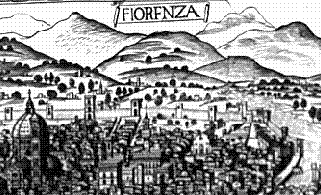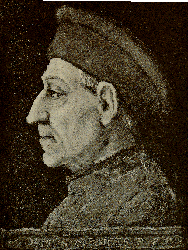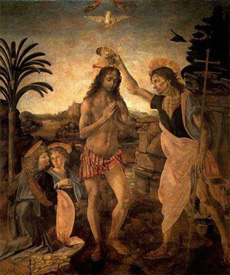Family Ruling Florence for Most of the Renaissance

![]()
Created past Sarah Barton, July 2003
![]()
What was significant nearly the Medici family, and why were its members able to stay in power for so long?
![]()
Overview
At the nascency of Florence equally an Italian Renaissance urban center-state is the medieval papacy. The Holy Roman Empire was constantly at war with the papacy, weakening its hold upon the regions that information technology governed. Slowly, Florence and other urban centers in Italy formed autonomous city-states that closely resembled those of the aboriginal Greeks. These city-states were rich urban centers whose elite grade had the coin, liberty and fourth dimension to explore the arts. Young Florence was ruled past rich merchants and aristocracy. The Italian city-states were not simply plagued past internal boxing betwixt the classes, but besides between each other. City-states waged wars confronting each other to gain control of the Mediterranean. It was these battles that spawned experimentation in government. The Florentines explored republicanism and humanism. Humanism played a large office in the Florentine republic. It was an intellectual move that strongly influenced the psychology of early on Florentine government. The motility encompassed man and how he related to the earth. Gone were the days of medieval fate-driven existence. Humans of a sudden awoke to a new world where the hereafter wasn't written for them. People no longer saw interest in the arts as blasphemous, nor did they see didactics as simply something express to the clergy. Petrarch, often considered to exist one of the fathers of Humanism, established the belief that humanism was a civic duty. Humanism and higher philosophy concerned not but the government officials, just likewise the general populace. In this style, Florence's accent on humanism every bit a borough duty is much like Greece'southward emphasis on the polis as an ideal way of life. By the centre of the fifteenth century, Florence was a thriving city-land with a population of threescore,000. Its ruling body consisted mainly of twelve rich merchant guilds that congregated at the Palazzo Vecchio to vote and discuss urban center issues. Florence institute its wealth in commerce and manufacture, not in state holdings as before societies had. The Florentine democracy discovered techniques that are feature of modernistic diplomacy, such equally the institution of embassies, intelligence reports, balance of power and alliances with other city-states. The most famous of these alliances was the Peace of Lodi, established in part by a and so rich Florentine broker, Cosimo Medici. The Peace of Lodi successfully stopped the abiding warring between metropolis-states, establishing a peace that lasted until the invasion of King Charles 8. Boiling under the surface were the condottieri, despotic rulers, who sought to take control of the young city-states and re-establish one-human rule. Out of all of the powerful Italian city-states, Florence was one that held out the longest. But fifty-fifty Florence fell to despotic rule, eventually, with the rise of the Medici family. The Italian Renaissance was a time of rebirth. The era was exemplified past experimentation in authorities, fine art, psychology and sociology. Florence was the city at the forefront of all of these developments. An example of Florence'southward influence on the Renaissance and its city-country neighbors is the florin, Florence'due south minted coinage that became the standard currency beyond all of Europe.
The Italian Renaissance was a time of rebirth. The era was exemplified past experimentation in authorities, fine art, psychology and sociology. Florence was the city at the forefront of all of these developments. An example of Florence'southward influence on the Renaissance and its city-country neighbors is the florin, Florence'due south minted coinage that became the standard currency beyond all of Europe.
The Medici family unit contributed to Florence in many ways. With the rise of a hereditary monarchy came a change in public philosophy. No longer considered a borough duty, humanism became a movement that applied to aristocrats the royal family. With ruling ability out of the easily of the public, information technology was now the sole duty of the ruling course to live up to humanist ideals of morality, ideals and learning. Florence was a articulate leader in all realms of Renaissance art, including sculpture, compages and painting. The city-country gave birth to such names as Michelangelo Buonarroti and Raphael Santi. At the root of Renaissance fine art was the rejection of medieval Gothic art and the rebirth of ancient Grecian fine art. Medieval fine art was concerned with somber spiritual themes, and while Renaissance fine art was still concerned with the spiritual attribute of things, it expressed a sense of control over one's ain destiny that medieval art did not have. In this way, humanism pervaded Renaissance art. This new art form was called the International Style. Florence was a shining case of the all-time of the Italian Renaissance. In politics Florence thrived, fostering new intellectual movements, such every bit humanism, likewise every bit experimentation in governmental administration. Much of modern government and lodge stands on the shoulders of Florentine giants. The strong rule of the Medici family kept Florence in the forefront of the Renaissance, and established a peace between the city-states that lasted over twoscore years. Florence excelled artistically, also. Well-known artists, such as Leonardo da Vinci and Raphael Santi, establish their footing as Florentine apprentices. Sculptors and architects, such as Filippo Brunellesci, gave to the world beautiful pieces of art that stand to this day, a tribute to their skill and craftsmanship. Florence was the epitome of Italian Renaissance glory. The Medici family rule finer began with Cosimo Medici who took over his male parent's banking company in 1429. Within five years, he gained significant political power in Florence, but it wasn't until his grandson, Lorenzo, destroyed the Florentine republican constitution in 1480 that the Medici family rule was solidified. The Medici family established a hereditary monarchy in Florence, the successors of Lorenzo having ruled until they were kicked out of Florence by Girolamo Savonarola in 1494.
The Medici family rule finer began with Cosimo Medici who took over his male parent's banking company in 1429. Within five years, he gained significant political power in Florence, but it wasn't until his grandson, Lorenzo, destroyed the Florentine republican constitution in 1480 that the Medici family rule was solidified. The Medici family established a hereditary monarchy in Florence, the successors of Lorenzo having ruled until they were kicked out of Florence by Girolamo Savonarola in 1494. Filippo Brunellesci led the Florentine classical revival. He was an architect who successfully adult the apply of perspective in art and explained it in mathematical terms. He is known for his work on the Bapistry doors, every bit well every bit his crucifix that resides in St. Maria Novella. Leonardo da Vinci, a tardily Renaissance artist, is nearly commonly known for the Mona Lisa, but he was also an engineer and a scientist. Although he was not built-in in Florence, he contributed to Florentine art and life. It was in Florence that Leonardo began his apprenticeship in 1466 with Andrea del Verrocchio. He went on to travel throughout the Italian city-states, spreading his knowledge of human anatomy, mechanics, engineering and, of course, art. The Florentine artists of the Renaissance were experimentalists in every sense of the word. They personalized art, and sought to explain it scientifically.
Filippo Brunellesci led the Florentine classical revival. He was an architect who successfully adult the apply of perspective in art and explained it in mathematical terms. He is known for his work on the Bapistry doors, every bit well every bit his crucifix that resides in St. Maria Novella. Leonardo da Vinci, a tardily Renaissance artist, is nearly commonly known for the Mona Lisa, but he was also an engineer and a scientist. Although he was not built-in in Florence, he contributed to Florentine art and life. It was in Florence that Leonardo began his apprenticeship in 1466 with Andrea del Verrocchio. He went on to travel throughout the Italian city-states, spreading his knowledge of human anatomy, mechanics, engineering and, of course, art. The Florentine artists of the Renaissance were experimentalists in every sense of the word. They personalized art, and sought to explain it scientifically.
![]()
Timeline
1252 - Minting of the outset golden florin
- 1299 - Palazzo Vecchio was built. The Palazzo Vecchio was the home of the ruling guilds of early Florence.
- 1350 – Italian Renaissance begins
- 1378 - Revolt of the Ciompi (wool-workers) in Florence. An example of the lower class wishing to take part in Florentine authorities.
- 1397 - Giovanni de Medici moves to Florence, and begins to accept role in Florentine public life.
- 1401 – Filippo Brunellesci and Ghiberti win the rights to sculpt the northern doors of the Bapistry, a Florentine church. They take 28 years to complete them.
- 1429 - Cosimo de Medici takes over his father'southward banking company, and within 5 years has political control over Florence.
- 1453 - Constantinople falls to the Ottoman Turks, sending many Greeks, and their influential art, to the Italian city-states.
- 1454 - Peace of Lodi was created mainly through the efforts of Cosimo Medici. The Peace of Lodi effectively ended warring between the metropolis-states for the next twoscore years.
- 1464 - Lorenzo de Medici ascends to power in Florence
1466 - Leonardo da Vinci begins his apprenticeship in Florence

- 1480 - Lorenzo de Medici completes the destruction of the Florentine republican constitution, signaling the consummate triumph of despotic rule over Florence
- 1486 - Pico publishes his collection of 900 treatises, and is declared a heretic past the Catholic Church building. Lorenzo de Medici saves him from death.
- 1494 - The Medici family is kicked out of Florence by Girolamo Savonarola.
The French King Charles VIII took Florence without a single shot, and briefly occupied it before returning to France.
- 1513 - The Florentine, Machiavelli, wrote The Prince.
- May half dozen, 1527 - Rome is sacked past the Spanish imperial regular army, an event that signifies the downfall of the Renaissance.
- 1600 – Italian Renaissance Ends
![]()
 Related Sites
Related Sites
Renaissance - Focus on Florence is a site by the Annenberg/CPB foundation that focuses on the many aspects of Renaissance Italian republic, such as trade and exploration. Office of the site explores Florence, individually. Family unit Portrait: The Medici of Florence follows the Medici bloodline from Giovanni to Anna Maria Luisa, the final of the Medici. This website shows a family tree of the Medicis. Renaissance Humanism is a lecture on the social move of the same proper name which was very prominent during that time. A comprehensive site on Italian Renaissance art is The Italian Renaissance Art Project , a database of images and biographies of major artists. Also focusing on art, Leonardo da Vinci is a very fun site that has very detailed information on da Vinci's life. This section of The Florentine Relate has the text of a primary source from 1348 that describes the effects of the Bubonic Plague on Florence.
There are a plethora of books published on the Italian Renaissance and Florence. A great book on all aspects of Florence and the Italian Renaissance, including politics and the church, is Factor Adam Brucker, Renaissance Florence (1983). Christopher Hibbert, The Business firm of Medici: Its Rise and Fall (1999), follows the lives of the Medici family, a dynasty of Florentine rulers during the Renaissance. David Klapisch-Zuber, Women, Family and Ritual in Renaissance Italy (1987), is a detailed look into the daily life of Renaissance families. Two books that explore the fine art of Renaissance Florence exclusively are Elizabeth Pilliod, Pontormo, Bronzino, and Allori: A Geneaology of Florentine Fine art (2001) and Antonio Paolucci, The Origins of Renaissance Art: The Baptistery Doors, Florence (1996).
![]()
This page is copyright © 2003, C.T. Evans and Sarah Barton.
For information contact cevans@nvcc.edu
Source: https://www.ctevans.net/Nvcc/Student/Florence/
0 Response to "Family Ruling Florence for Most of the Renaissance"
ارسال یک نظر